For a long time I wanted to see the original 100-year-old straw bale buildings in Nebraska, so on a drive across the continent I included Nebraska on the tour. My first stop was Arthur Nebraska, where I met up with Jake and Lucille Cross.
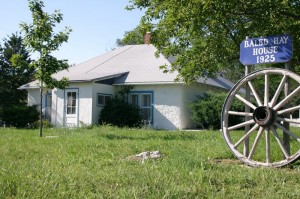 Jake Cross took me to see the Martin/Monhart house, a home that was built in 1925 out of baled late-season hay. It was formerly owned by his wife Lucille’s parents. What struck me most about this house is how normal it looks. Modern straw bale homes emphasize the straw, with rounded corners, unique plasters, and often slightly wavy or uneven walls. My first thought was that the inside of the Martin/Monhart house had drywall over top of the bale walls, they were straight and flat and covered with wallpaper. This could have been my grandparents’ house. Jake had me stand right beside the wall and look down its length; from this vantage point a slight wave could be seen where the wall meets the ceiling- what I mistook for drywall was the bale wall itself. Only in the windows could the depth of the walls be seen, showing the tremendous insulation value of nearly two feet of baled hay. Lucille told me the story of the day a tornado roared through the town, tearing up trees, blowing out windows and sounding like a freight train running through the middle of town. As soon as the tornado had passed Lucille went to check on her parents only a block away from the path of destruction. “We found them playing cards,” she recounted, “they had no idea a tornado had passed, they didn´t believe us at first.” Bales are a great insulator against sound as well as temperature. Standing there surrounded by the old furniture, I could imagine the couple peacefully playing cards, blissfully unaware of the destruction that came so close.
Jake Cross took me to see the Martin/Monhart house, a home that was built in 1925 out of baled late-season hay. It was formerly owned by his wife Lucille’s parents. What struck me most about this house is how normal it looks. Modern straw bale homes emphasize the straw, with rounded corners, unique plasters, and often slightly wavy or uneven walls. My first thought was that the inside of the Martin/Monhart house had drywall over top of the bale walls, they were straight and flat and covered with wallpaper. This could have been my grandparents’ house. Jake had me stand right beside the wall and look down its length; from this vantage point a slight wave could be seen where the wall meets the ceiling- what I mistook for drywall was the bale wall itself. Only in the windows could the depth of the walls be seen, showing the tremendous insulation value of nearly two feet of baled hay. Lucille told me the story of the day a tornado roared through the town, tearing up trees, blowing out windows and sounding like a freight train running through the middle of town. As soon as the tornado had passed Lucille went to check on her parents only a block away from the path of destruction. “We found them playing cards,” she recounted, “they had no idea a tornado had passed, they didn´t believe us at first.” Bales are a great insulator against sound as well as temperature. Standing there surrounded by the old furniture, I could imagine the couple peacefully playing cards, blissfully unaware of the destruction that came so close.
The Martin/Monhart house was one of the later homes to be built in the original wave of Nebraska bale building. One of the first was an 1886 school house, which suffered an ignominious fate. Unfenced and unstuccoed, by 1902 it was reported that
the building had been eaten by cows. The invention of straw and hay bale homes in the sandhills of Nebraska was almost inevitable because of a combination of factors. The first was the invention of the horse powered hay press (hay baler) around the 1870’s-1880’s, which for the first time created the raw material for bale homes. Secondly, the traditional Nebraska sod house didn´t work all that well in the sandhills. The turf on the uplands tended to fall apart easily and the soil in the lowlands was too valuable for growing crops to use it as a building material, if any alternative could be found. Nebraska resourcefulness and technological progress met in the sandhills and the bale house was born.
After leaving Arthur, I Visited the Haslow house, which took me through the heart of the sandhills.
I pull over to the side of the road. It’s perfectly still, but stormclouds form great anvils on the horizon. In the sandhills, especially around sunset, the land and the sky somehow seem equally real and equally fanciful, as though reality lives somewhere in between. The sandhills have a surprisingly dramatic, otherworldly beauty to them.
Rich Haslow is a rancher who runs the operations of the Nebraska Boys Ranch. In some ways he´s pretty traditional, for instance he´s one of the few farmers around who still stores his hay in stacks instead of bales.
Someone had a baling machine here at least once though, in 1913. That was the year Jason Snow built a house here out of rushes baled from a shallow lake that still lies behind the house, and which to this day remains filled with a thick cover of tall rushes (it is named Rush Lake). This baling up of whatever was at hand to use as a building material was typical. Many of the original bale homes were made from wild prairie grasses dominated by little bluestem, harvested from the hills late in the season and carted down to the stationary horse-powered hay press to be made into bales. Other houses were built from various straws such as rye straw, or from rushes as the Haslow house was. The term stationary hay press is a bit deceiving, as they tended to move from farm to farm, hired out for a few days at a time to bale hay for sale, storage, or building.
The Haslow house was built in the traditional “Nebraska style,” or load bearing form. This simply means that the weight of the roof sits directly on the straw wall with no wood framing. Post and beam homes with straw in-fill are more common than load bearing ones in modern straw bale construction (though both are common), but the original bale buildings were made to use as little wood as possible. Just as in sod houses, no wood was needed to support the roof in bale buildings.
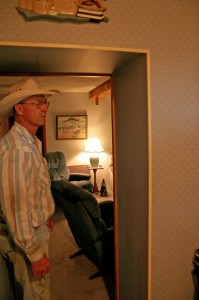
Nebraska style buildings have stood the test of time – the Haslow house still wears its original coat of 1913 stucco, which is in good shape other than a little cracking and settling. The hay used in these houses has little or no rot after nearly 100 years. Standing in his 100-year-old bale home, Rich Haslow related a story to that effect. “They tore down one of these old bale houses near Lakeside, they spread the hay out on the ground and the cows ate it!” The only problem in his own house was that the hay can trigger Rich´s allergies, which is a problem that is not usually seen in newer bale buildings. Modern bale buildings are nearly always built with straw, which is less likely to have issues with rot, or allergies – perhaps that´s the difference, or maybe there are just more gaps in the wall 100 years later. Despite the allergies Rich said “we have no complaints. It´s a good little house.”
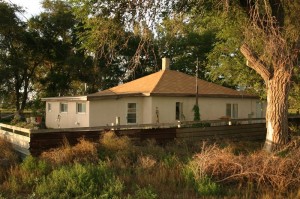
Before I left he took me to see a nearby sod house. Rich and Rhonda Halsow started their marriage in this house, while his parents were living in the bale house. “We think we might be the only couple of our generation that started off our marriage in a sod house,” Rhonda said. Fitting, perhaps that they followed it up with a bale home. A thunderstorm was crossing the horizon as I drove off.

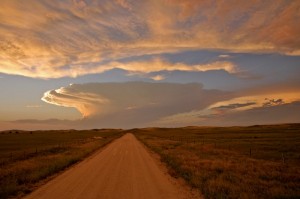
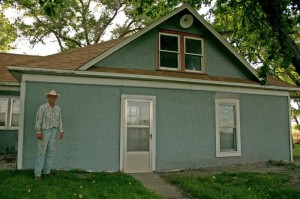
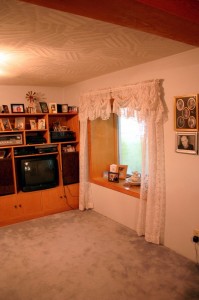
This is wonderful. Straw bale homes are very strong. They have a hr. fire rating which is better than most conventional homes. We(me and The Action Not Words Project nonprofit), will be building straw bale homes here near Atlanta GA for a sustainable village for senior citizens and displaced veterans.I can’t to start building!
Hello, I am currently living in a very old house with a wood frame and straw bale insulation. It is located in the center of France.
You can see it on our straw construction site. We are interested in contacts about ecological construction in your country and more particularly in straw bales.
Thank you
Mickey from the National Straw Construction Center